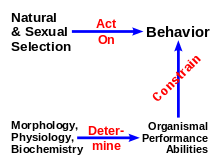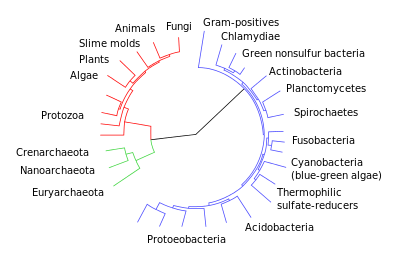Evolutionary physiology

| Part of a series on |
| Evolutionary biology |
|---|
 |
|
History of evolutionary theory |
|
Fields and applications
|
|
Evolutionary physiology is the study of physiological evolution, which is to say, the manner in which the functional characteristics of individuals in a population of organisms have responded to selection across multiple generations during the history of the population.[1]
It is a subdiscipline of both physiology and evolutionary biology. Practitioners in this field come from a variety of backgrounds, including physiology, evolutionary biology, ecology and genetics.
Accordingly, the range of phenotypes studied by evolutionary physiologists is broad, including life history, behavior, whole-organism performance,[2][3] functional morphology, biomechanics, anatomy, classical physiology, endocrinology, biochemistry, and molecular evolution. It is closely related to comparative physiology and environmental physiology, and its findings are a major concern of evolutionary medicine.
History
As the name implies, evolutionary physiology is the product of what was at one time two distinct scientific disciplines. According to Garland and Carter,[1] evolutionary physiology arose in the late 1970s, following debates concerning the metabolic and thermoregulatory status of dinosaurs (see physiology of dinosaurs) and mammal-like reptiles.
This period was followed by attempts in the early 1980s to integrate quantitative genetics into evolutionary biology, which had spill-over effects on other fields, such as behavioral ecology and ecophysiology. In the mid- to late-1980s, phylogenetic comparative methods started to become popular in many fields, including physiological ecology and comparative physiology. A 1987 volume titled "New Directions in Ecological Physiology"[4] had little ecology[5] but a considerable emphasis on evolutionary topics. It generated vigorous debate, and within a few years the National Science Foundation had developed a panel titled Ecological and Evolutionary Physiology.
Shortly thereafter, selection experiments and experimental evolution became increasingly common in evolutionary physiology. Macrophysiology has emerged as a subdiscipline, in which practitioners attempt to identify large-scale patterns in physiological traits (e.g., patterns of covariation with latitude) and their ecological implications.[6] [7] [8]
More recently, the importance of a merger of evolutionary biology and physiology has been argued from the perspective of functional analyses, epigenetics, and an extended evolutionary synthesis.[9]
Emergent properties
As a hybrid scientific discipline, evolutionary physiology provides some unique perspectives. For example, an understanding of physiological mechanisms can help in determining whether a particular pattern of phenotypic variation or covariation (such as an allometric relationship) represents what could possibly exist or just what selection has allowed.[1] Similarly, a thorough knowledge of physiological mechanisms can greatly enhance understanding of possible reasons for evolutionary correlations and constraints than is possible for many of the traits typically studied by evolutionary biologists (such as morphology).
Areas of research
Important areas of current research include:
- Organismal performance as a central phenotype (e.g., measures of speed or stamina in animal locomotion)
- Role of behavior in physiological evolution
- Physiological and endocrinological basis of variation in life history traits (e.g., clutch size)
- Functional significance of molecular evolution
- Extent to which species differences are adaptive
- Physiological underpinnings of limits to geographic ranges
- Geographic variation in physiology[10]
- Role of sexual selection in shaping physiological evolution
- Magnitude of "phylogenetic signal" in physiological traits
- Role of pathogens and parasites in physiological evolution and immunity
- Application of optimality modeling to elucidate the degree of adaptation
- Role of phenotypic plasticity in accounting for individual, population, and species differences[11]
- Mechanistic basis of trade-offs and constraints on evolution (e.g., putative Carrier's constraint on running and breathing)
- Limits on sustained metabolic rate
- Origin of allometric scaling relations or allometric laws (and the so-called metabolic theory of ecology)
- Individual variation (see also Individual differences psychology)
- Functional significance of biochemical polymorphisms
- Analysis of physiological variation via quantitative genetics
- Paleophysiology and the evolution of endothermy
- Human adaptational physiology
- Darwinian medicine
- Evolution of dietary antioxidants
Techniques
- Artificial selection and experimental evolution [12] mouse wheel running video
- Genetic analyses and manipulations[1]
- Measurement of selection in the wild [13]
- Phenotypic plasticity and manipulation[1]
- Phylogenetically based comparisons[14]
- Doubly labeled water measurements of free-living energy demands of animals
Funding and societies
In the United States, research in evolutionary physiology is funded mainly by the National Science Foundation. A number of scientific societies feature sections that encompass evolutionary physiology, including:
- American Physiological Society "integrating the life sciences from molecule to organism"
- Society for Integrative and Comparative Biology
- Society for Experimental Biology
Some journals that frequently publish articles in evolutionary physiology
- American Naturalist
- Comparative Biochemistry and Physiology
- Comprehensive Physiology
- Ecology
- Evolution
- Functional Ecology
- Integrative and Comparative Biology
- Journal of Comparative Physiology
- Journal of Evolutionary Biochemistry and Physiology
- Journal of Experimental Biology
- Physiological and Biochemical Zoology
See also
- Allometry
- Allometric law
- Beneficial acclimation hypothesis
- Comparative physiology
- Darwinian medicine
- Field metabolic rate
- Ecophysiology
- Evolutionary neuroscience
- Evolutionary psychology
- Experimental evolution
- Human physiology
- I. M. Sechenov Institute of Evolutionary Physiology and Biochemistry
- Kleiber's law
- Krogh Principle
- John Speakman
- Leon Orbeli
- Life history theory
- List of physiologists
- Metabolic theory of ecology
- Peter Hochachka
- Phenotypic plasticity
- Phylogenetic comparative methods
- Physiology
- Physiology of dinosaurs
- Raymond B. Huey
- Theodore Garland, Jr.
- Thrifty phenotype
References
- 1 2 3 4 5 Garland, T., Jr.; P. A. Carter (1994). "Evolutionary physiology" (PDF). Annual Review of Physiology. 56: 579–621. doi:10.1146/annurev.ph.56.030194.003051. PMID 8010752.
- ↑ Arnold, S. J. (1983). "Morphology, performance and fitness" (PDF). American Zoologist. 23: 347–361. doi:10.1093/icb/23.2.347.
- ↑ Careau, V. C.; T. Garland, Jr. (2012). "Performance, personality, and energetics: correlation, causation, and mechanism" (PDF). Physiological and Biochemical Zoology. 85: 543–571. doi:10.1086/666970. PMID 23099454.
- ↑ Feder, M. E.; A. F. Bennett; W. W. Burggren; R. B. Huey, eds. (1987). New directions in ecological physiology. New York: Cambridge Univ. Press. ISBN 0-521-34938-9.
- ↑ Kingsolver, J. G (1988). "Evolutionary physiology: Where's the ecology? A review of New Directions in Ecological physiology, Feder et al. 1987". Ecology. 69: 1644. doi:10.2307/1941674.
- ↑ Chown, S. L.; K. J. Gaston; D. Robinson (2004). "Macrophysiology: large-scale patterns in physiological traits and their ecological implications". Functional Ecology. 18 (2): 159–167. doi:10.1111/j.0269-8463.2004.00825.x.
- ↑ Gaston, K. J., S. L. Chown, P. Calosi, J. Bernardo, D. T. Bilton, A. Clarke, S. Clusella‐Trullas, C. K. Ghalambor, M. Konarzewski, L. S. Peck, W. P. Porter, H. O. Pörtner, E. L. Rezende, P. M. Schulte, J. I. Spicer, J. H. Stillman, J. S. Terblanche, and M. van Kleunen. 2009. Macrophysiology: a conceptual reunification. The American Naturalist 174:595–612.
- ↑ Chown, S. L., and K. J. Gaston. 2015. Macrophysiology - progress and prospects. Functional Ecology 30:330-344.
- ↑ Noble, D., E. Jablonka, M. J. Joyner, G. B. Müller, and S. W. Omholt. 2014. Evolution evolves: physiology returns to centre stage. The Journal of Physiology 592:2237–2244.
- ↑ Garland, T., Jr.; S. C. Adolph (1991). "Physiological differentiation of vertebrate populations" (PDF). Annual Review of Ecology and Systematics. 22: 193–228. doi:10.1146/annurev.ecolsys.22.1.193.
- ↑ Kelly, S. A.; T. Panhuis; A. Stoehr (2012). "Phenotypic plasticity: molecular mechanisms and adaptive significance". Comprehensive Physiology. 2: 1417–1439. doi:10.1002/cphy.c110008.
- ↑ Bennett, A. F.; R. E. Lenski (1999). "Experimental evolution and its role in evolutionary physiology" (PDF). American Zoologist. 39 (2): 346–362. doi:10.1093/icb/39.2.346.
- ↑ Irschick, D. J.; J. J. Meyers; J. F. Husak; J.-F. Le Galliard (2008). "How does selection operate on whole-organism functional performance capacities? A review and synthesis" (PDF). Evolutionary Ecology Research. 10: 177–196. CiteSeerX 10.1.1.371.8464
 . ISSN 0003-1569.
. ISSN 0003-1569. - ↑ Garland, T., Jr.; A. F. Bennett; E. L. Rezende (2005). "Phylogenetic approaches in comparative physiology" (PDF). Journal of Experimental Biology. 208 (Pt 16): 3015–3035. doi:10.1242/jeb.01745. PMID 16081601.
External links
- People, Labs, and Programs in Evolutionary Physiology
- Evolutionary Systems Biology - Some Important Papers
